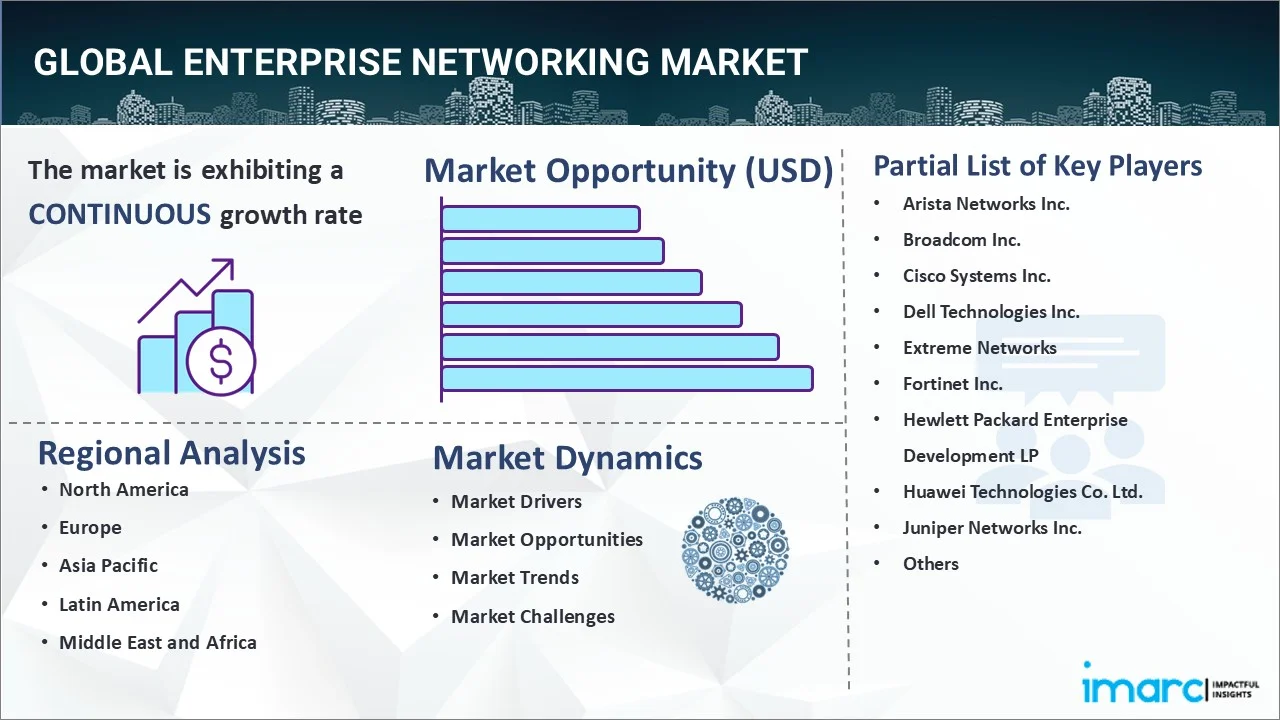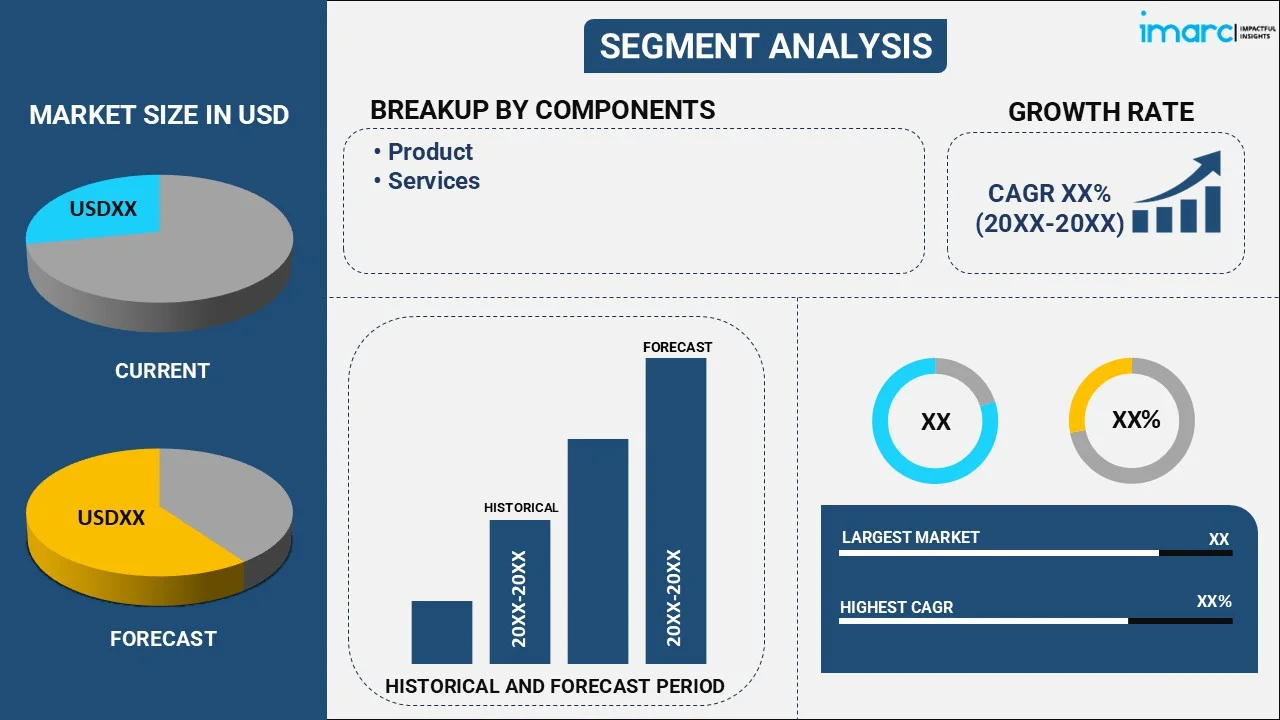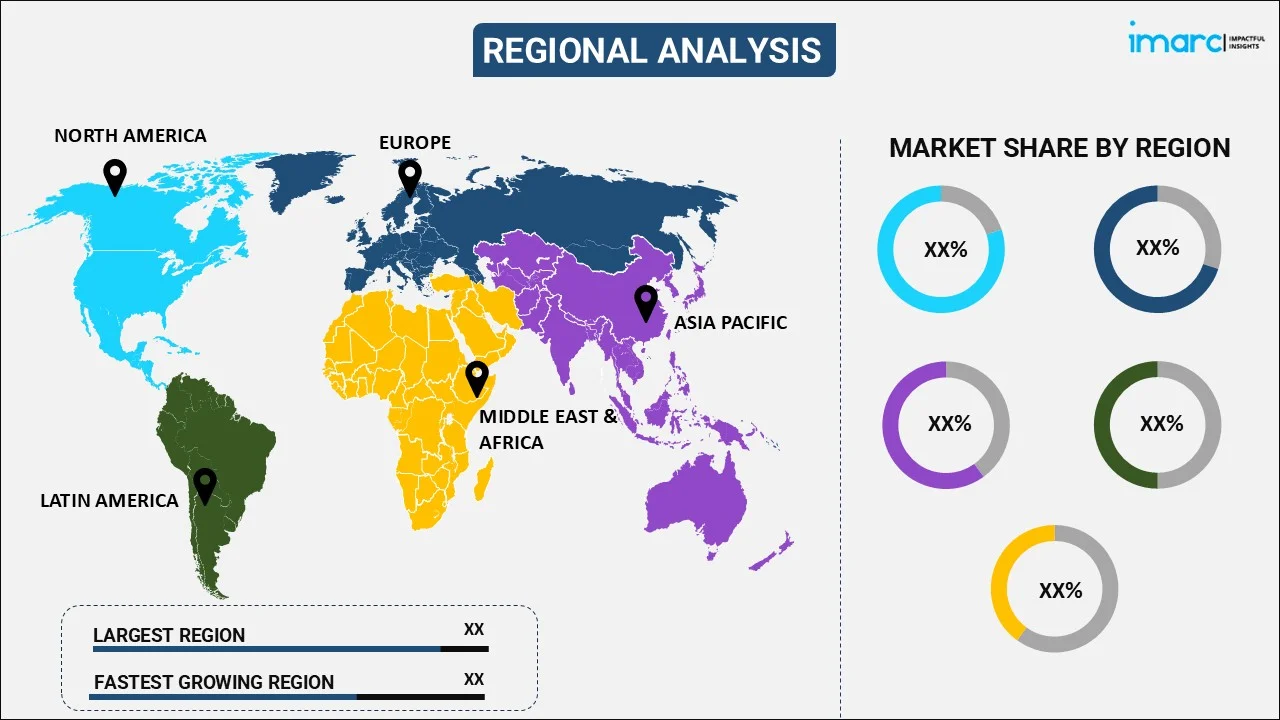
Enterprise Networking Market Report by Component (Product, Services), Deployment Mode (Cloud-based, On-Premises), Organization Size (Large Enterprises, Small and Medium-sized Enterprises (SMEs)), End User (Aerospace and Defense, Education, Media and Communication, Healthcare, BFSI, Transportation and Logistics, and Others), and Region 2025-2033
Enterprise Networking Market Size:
The global enterprise networking market size reached USD 64.4 Billion in 2024. Looking forward, IMARC Group expects the market to reach USD 99.7 Billion by 2033, exhibiting a growth rate (CAGR) of 4.98% during 2025-2033. The expanding adoption of wireless devices, the growing penetration of virtualization technologies and the Internet of Things (IoT), and the rising focus on network security and privacy are some of the major factors propelling the market.
|
Report Attribute
|
Key Statistics
|
|---|---|
|
Base Year
|
2024 |
|
Forecast Years
|
2025-2033
|
|
Historical Years
|
2019-2024
|
| Market Size in 2024 | USD 64.4 Billion |
| Market Forecast in 2033 | USD 99.7 Billion |
| Market Growth Rate 2025-2033 |
4.98%
|
Enterprise Networking Market Analysis:
- Market Growth and Size: The market is witnessing moderate growth, which can be attributed to the increasing digitization across industries and the adoption of cloud-based services.
- Major Market Drivers: The increasing demand for high-speed data connectivity and seamless communication solutions is propelling the enterprise networking market growth. The proliferation of Internet of Things (IoT) devices and the need for efficient data management and security are catalyzing the demand for advanced networking solutions.
- Key Market Trends: Software-defined networking (SDN) is gaining traction, offering flexibility, scalability, and centralized management of network infrastructure. The integration of artificial intelligence (AI) and machine learning (ML) into networking solutions is enabling predictive analytics and proactive network management.
- Geographical Trends: North America leads the market on account of technological advancements, particularly in sectors like healthcare, finance, and IT. However, Asia Pacific is emerging as a fast-growing market, driven by rapid industrialization, urbanization, and increasing investments in IT infrastructure.
- Competitive Landscape: Strategic partnerships and mergers and acquisitions (M&A) are common strategies adopted by key players to expand their market presence and enhance product portfolios. They are also investing in research and development (R&D) initiatives to stay at the forefront of technological advancements.
- Challenges and Opportunities: While the market faces challenges, such as security concerns, such as data breaches and cyber threats, it also encounters opportunities in 5G technology that results in enhanced connectivity and network performance, driving the adoption of next-generation networking solutions.

Enterprise Networking Market Trends:
Growing adoption of wireless devices
The proliferation of smartphones, tablets, laptops, and other wireless devices in the workplace has propelled the demand for enterprise networking solutions capable of accommodating large numbers of devices and ensuring reliable connectivity. In addition to this, the increasing demand for wireless devices to allow employees the flexibility to work from anywhere within the network coverage area is acting as another significant growth-inducing factor. Besides this, the emerging trend of BYOD, where employees use personal devices for work purposes, is creating a favorable outlook for the market. Furthermore, the convergence of wireless devices, cloud computing, and edge computing has created new networking requirements that can support seamless integration with cloud services and edge devices, enabling efficient data processing and storage.
Expanding proliferation of the Internet of Things (IoT) and virtualization technologies
Enterprise networking solutions are crucial in enabling seamless communication between IoT devices, connecting them to cloud platforms and providing the necessary infrastructure for secure and efficient IoT deployments. Apart from this, the widespread employment of virtualization technologies, such as server virtualization and network virtualization in organizations, to optimize resources, enhance scalability, and improve cost efficiency is contributing to the market growth. Moreover, the expanding need to process and analyze massive volumes of data is impelling the adoption of scalable and high-performance networking infrastructure such as enterprise networking. Furthermore, the surging adoption of Software-Defined Networking (SDN) in organizations due to their ability to centrally manage and control network infrastructure, improving flexibility, scalability, and cost efficiency, is aiding in market expansion.
The emerging trends of enterprise mobility and remote work
The rising trends of remote work, accelerated by the COVID-19 pandemic, represent one of the key factors driving the market growth. In line with this, the surging demand for enterprise networking solutions, including virtual private networks (VPNs) and remote access technologies, as they play a crucial role in enabling secure remote connectivity, is propelling the market forward. Moreover, the growing penetration of cloud-based collaboration tools, such as video conferencing, file sharing, and project management platforms, has further enhanced the need for reliable, high-performance networking infrastructure to facilitate seamless communication among remote teams. Additionally, the escalating concerns about data security and protection due to expanding adoption of mobility and remote work are prompting businesses to employ networking solutions integrated with robust security measures, such as secure access controls, encryption, and threat detection.
Enterprise Networking Industry Segmentation:
IMARC Group provides an analysis of the key trends in each segment of the global enterprise networking market, along with forecasts at the global, regional, and country levels from 2025-2033. Our report has categorized the market based on component, deployment mode, organization size, and end user.
Breakup by Component:

- Product
- Services
Services is dominating the enterprise networking
The report has provided a detailed breakup and analysis of the enterprise networking market based on the component. This includes product and services. According to the report, services represented the largest segment.
The rising demand for various enterprise networking products and services to provide enhanced connectivity among different devices, allowing employees to connect, share resources, and access internal and external applications, represents the prime factor driving the market growth. Moreover, the increasing use of wide area networking (WAN) technologies, such as multiprotocol label switching (MPLS), Software-Defined (SD) WAN, and VPN, to establish secure connections between branch offices, remote workers, and data centers is strengthening the market growth. In addition to this, the widespread demand for network security solutions, including firewalls, intrusion detection and prevention systems, and secure access controls to protect against cyber threats and ensure the privacy of sensitive data, is positively impacting the market growth.
Breakup by Deployment Mode:
- Cloud-based
- On-Premises
On-premises hold a larger share in enterprise networking
A detailed breakup and analysis of the enterprise networking market based on the deployment mode has also been provided in the report. This includes cloud-based and on-premises. According to the report, on-premises accounted for the largest enterprise networking market share.
The rising employment of on-premises networking solutions to provide organizations with greater control over their network infrastructure, implement customized security measures, and maintain compliance with specific regulatory requirements is aiding in market expansion. Besides this, on-premises networking solutions are highly preferred among organizations that require low latency and high performance for particular applications or data-intensive processes, which is creating a positive enterprise networking market outlook. Furthermore, the expanding trend of cloud computing is fueling the demand for cloud-based networking to enable scalability and provide remote accessibility, making it easier for employees to collaborate and work together.
Breakup by Organization Size:
- Large Enterprises
- Small and Medium-sized Enterprises (SMEs)
Large enterprises are dominating the enterprise networking
The report has provided a detailed breakup and analysis of the enterprise networking market based on the organization size. This includes large enterprises, and small and medium-sized enterprises (SMEs). According to the report, large enterprises represented the largest segment.
The increasing number of SMEs around the world is propelling the demand for cost-effective and highly scalable cloud-based networking and subscription-based services due to their limited IT budgets and resources. Concurrent with this, the rising demand for robust networking solutions across large enterprises to handle high volumes of network traffic, support multiple locations, and integrate various systems and applications is contributing to the market growth. Besides this, the increasing incorporation of advanced technologies like cloud computing, IoT, AI, ML, big data analytics, and unified communications and collaboration tools in various operations to enhance productivity and efficiency is aiding in market expansion.
Breakup by End User:
- Aerospace and Defense
- Education
- Media and Communication
- Healthcare
- BFSI
- Transportation and Logistics
- Others
BFSI hold a larger share in enterprise networking
A detailed breakup and analysis of the enterprise networking market based on the end user has also been provided in the report. This includes aerospace and defense, education, media and communication, healthcare, BFSI, transportation and logistics, and others. According to the report, BFSI accounted for the largest market share.
The growing product utilization among defense agencies, military bases, and aerospace organizations to enable secure and reliable connectivity for mission-critical applications and remote collaboration is strengthening the market growth. Besides this, the increasing product employment in the BFSI sector to facilitate real-time transactions, secure data exchange, and robust connectivity for online banking, financial trading, and insurance services are positively impacting the market growth. Moreover, the rising popularity of online learning and the escalating demand for digital classrooms and campus-wide connectivity across schools, colleges, and universities is presenting remunerative growth opportunities for the market.
Breakup by Region:

- North America
- United States
- Canada
- Europe
- Germany
- France
- United Kingdom
- Italy
- Spain
- Others
- Asia Pacific
- China
- Japan
- India
- South Korea
- Australia
- Indonesia
- Others
- Latin America
- Brazil
- Mexico
- Others
- Middle East and Africa
North America exhibits a clear dominance in the market, accounting for the largest market share
The report has also provided a comprehensive analysis of all the major regional markets, which include North America (the United States and Canada); Europe (Germany, France, the United Kingdom, Italy, Spain, and others); Asia Pacific (China, Japan, India, South Korea, Australia, Indonesia, and others); Latin America (Brazil, Mexico, and others); and the Middle East and Africa.
North America is known for its technological advancements and early adoption of new technologies. The region's drive for innovation and the presence of tech giants fuels the demand for advanced enterprise networking solutions. Concurrent with this, ongoing digital transformation and the expanding deployment of high-speed fifth-generation (5G) connectivity across the region are propelling the enterprise networking market forecast.
Competitive Landscape:
The global enterprise networking market is highly competitive and distinguished by the presence of several key players offering a wide range of networking solutions and services. The competitive landscape is shaped by factors such as technological innovation, product differentiation, strategic partnerships, and customer-centric approaches. Major players in the market invest extensively in research and development (R&D) initiatives to stay at the forefront of technological advancements. The enterprise networking market research also allows key players to understand the importance of providing excellent customer support, offering flexible pricing models and delivering scalable and secure networking solutions to meet the diverse needs of enterprises. Moreover, key players are focusing on expanding their market presence by adopting numerous growth strategies such as mergers and acquisitions, partnerships, collaborations, and product launches. To gain a competitive edge, companies engage in strategic partnerships and acquisitions to expand their product portfolios and enhance their market presence.
The report has provided a comprehensive analysis of the competitive landscape in the global enterprise networking market. Detailed profiles of all major companies have also been provided. Some of the key players in the global enterprise networking market include:
- Arista Networks Inc.
- Broadcom Inc.
- Cisco Systems Inc.
- Dell Technologies Inc.
- Extreme Networks
- Fortinet Inc.
- Hewlett Packard Enterprise Development LP
- Huawei Technologies Co. Ltd.
- Juniper Networks Inc.
- Netscout Systems Inc.
- Nokia Corporation
- Riverbed Technology
Recent Developments:
- In May 2023, Cisco Systems Inc. announced the creation of core manufacturing capabilities in India, including testing, development and logistics, and expanding in-house repair operations.
- In May 2023, Broadcom Inc. and Apple Inc. unveiled a substantial partnership focusing on the development and production of critical 5G radio frequency components in the US.
- In May 2023, Dell Technologies Inc. and NVIDIA announced a joint initiative, ‘Project Helix’ to make it easier for businesses to build and use generative AI models on-premises. This will further enable them to quickly and securely deliver better customer service, market intelligence, enterprise search, and a range of other capabilities.
Enterprise Networking Market Report Scope:
| Report Features | Details |
|---|---|
| Base Year of the Analysis | 2024 |
| Historical Period | 2019-2024 |
| Forecast Period | 2025-2033 |
| Units | Billion USD |
| Scope of the Report | Exploration of Historical and Forecast Trends, Industry Catalysts and Challenges, Segment-Wise Historical and Predictive Market Assessment:
|
| Components Covered | Product, Services |
| Deployment Modes Covered | Cloud-based, On-Premises |
| Organization Sizes Covered | Large Enterprises, Small and Medium-sized Enterprises (SMEs) |
| End Users Covered | Aerospace and Defense, Education, Media and Communication, Healthcare, BFSI, Transportation and Logistics, Others |
| Regions Covered | Asia Pacific, Europe, North America, Latin America, Middle East and Africa |
| Countries Covered | United States, Canada, Germany, France, United Kingdom, Italy, Spain, China, Japan, India, South Korea, Australia, Indonesia, Brazil, Mexico |
| Companies Covered | Arista Networks Inc., Broadcom Inc., Cisco Systems Inc., Dell Technologies Inc., Extreme Networks, Fortinet Inc., Hewlett Packard Enterprise Development LP, Huawei Technologies Co. Ltd., Juniper Networks Inc., Netscout Systems Inc., Nokia Corporation, Riverbed Technology, etc. |
| Customization Scope | 10% Free Customization |
| Post-Sale Analyst Support | 10-12 Weeks |
| Delivery Format | PDF and Excel through Email (We can also provide the editable version of the report in PPT/Word format on special request) |
Key Benefits for Stakeholders:
- IMARC’s report offers a comprehensive quantitative analysis of various market segments, historical and current market trends, market forecasts, and dynamics of the enterprise networking market from 2019-2033.
- The research study provides the latest information on the market drivers, challenges, and opportunities in the global enterprise networking market.
- The study maps the leading, as well as the fastest-growing, regional markets. It further enables stakeholders to identify the key country-level markets within each region.
- Porter's five forces analysis assist stakeholders in assessing the impact of new entrants, competitive rivalry, supplier power, buyer power, and the threat of substitution. It helps stakeholders to analyze the level of competition within the enterprise networking industry and its attractiveness.
- Competitive landscape allows stakeholders to understand their competitive environment and provides an insight into the current positions of key players in the market.
Key Questions Answered in This Report
The enterprise networking market was valued at USD 64.4 Billion in 2024.
The enterprise networking market is projected to exhibit a CAGR of 4.98% during 2025-2033, reaching a value of USD 99.7 Billion by 2033.
Key drivers of the enterprise networking market include rapid digital transformation, soaring data and cloud traffic, remote work proliferation, and IoT/edge computing expansion. Additionally, 5G rollouts, AI/ML-enabled network automation, SDN/SD-WAN adoption, stringent cybersecurity needs, and hybrid/multi-cloud architectures fuel growth.
North America currently dominates the enterprise networking market due to rapid digital transformation, widespread cloud/hybrid-multi-cloud adoption, remote/hybrid workforces, IoT and edge demand, AI-enabled SD-WAN and network automation, 5G rollouts, and stringent cybersecurity requirements.
Some of the major players in the enterprise networking market include Arista Networks Inc., Broadcom Inc., Cisco Systems Inc., Dell Technologies Inc., Extreme Networks, Fortinet Inc., Hewlett-Packard Enterprise Development LP, Huawei Technologies Co. Ltd., Juniper Networks Inc., Netscout Systems Inc., Nokia Corporation, Riverbed Technology, etc.
Need more help?
- Speak to our experienced analysts for insights on the current market scenarios.
- Include additional segments and countries to customize the report as per your requirement.
- Gain an unparalleled competitive advantage in your domain by understanding how to utilize the report and positively impacting your operations and revenue.
- For further assistance, please connect with our analysts.
 Request Customization
Request Customization
 Speak to an Analyst
Speak to an Analyst
 Request Brochure
Request Brochure
 Inquire Before Buying
Inquire Before Buying




.webp)




.webp)












